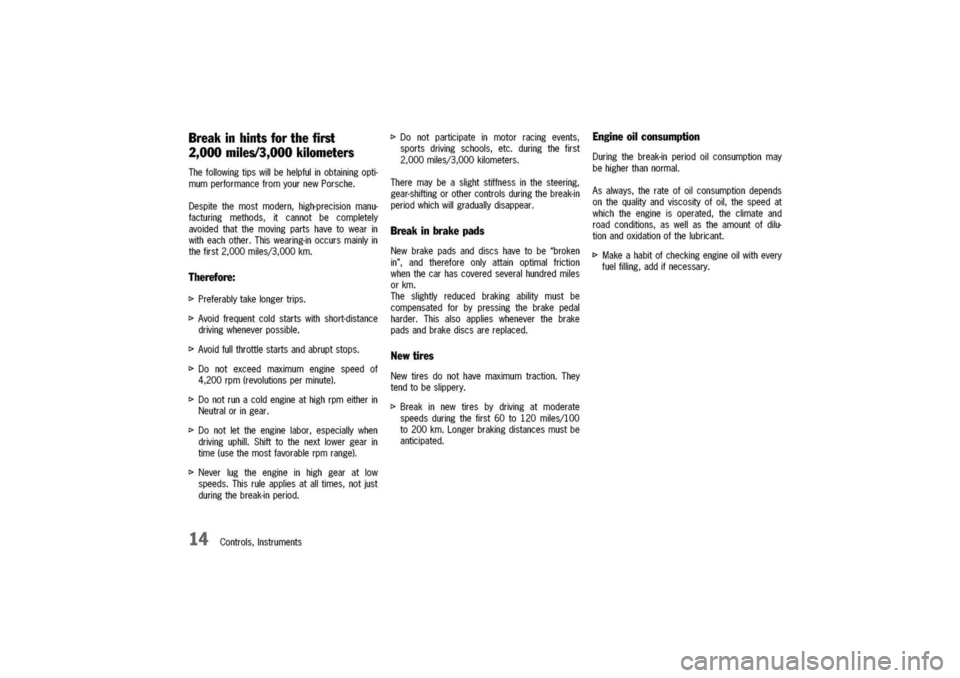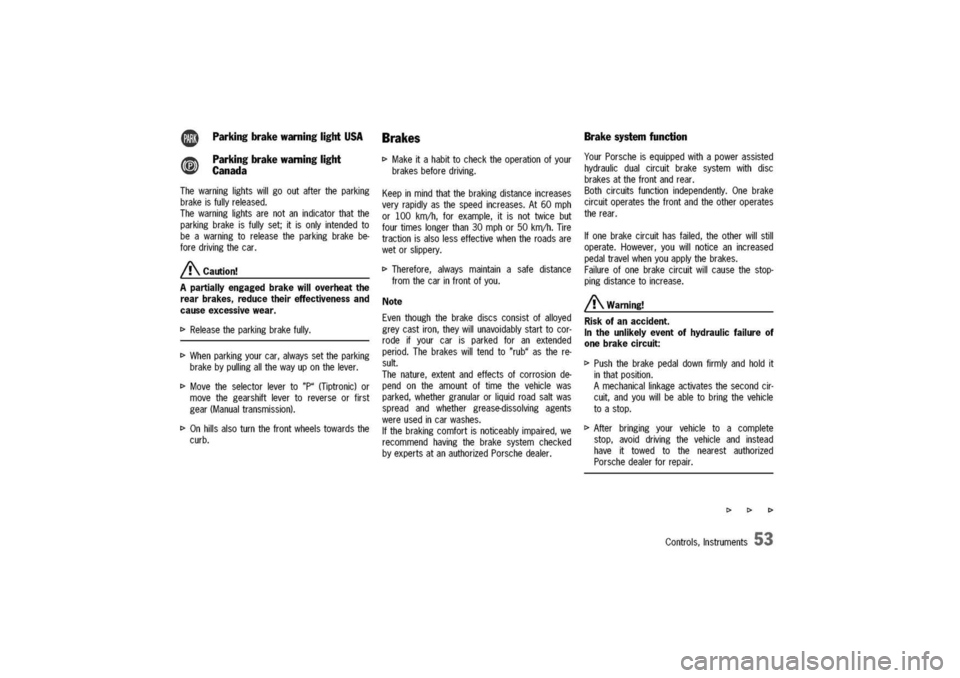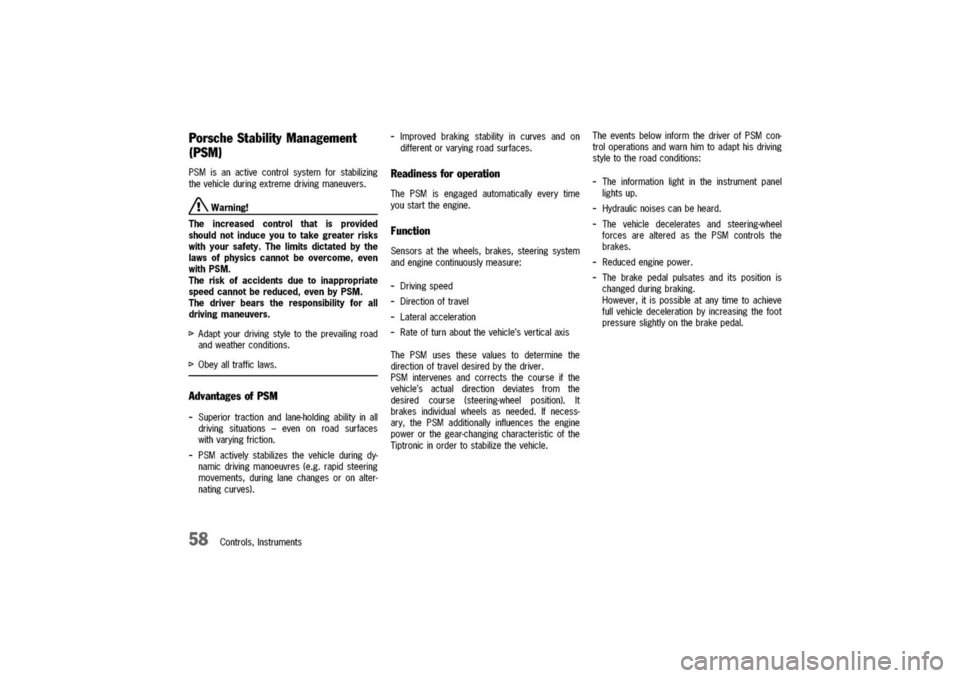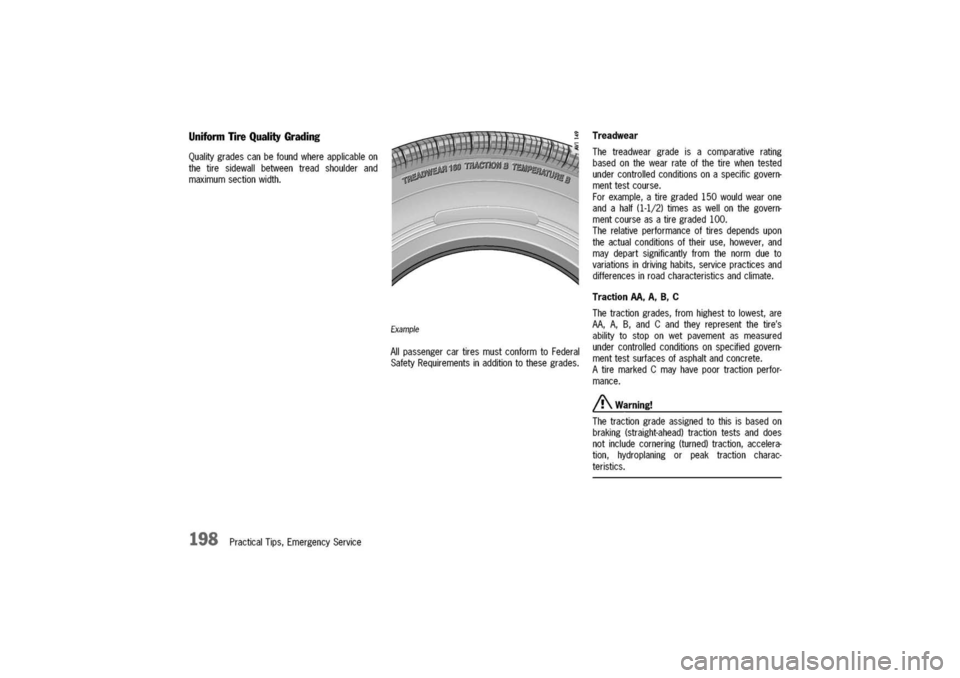2003 PORSCHE 911 CARRERA traction control
[x] Cancel search: traction controlPage 14 of 263

Breakinhintsforthefirst
2,000
miles/3,000kilometers
Thefollowingtipswillbehelpfulinobtainingopti-
mumperformancefromyournewPorsche.
Despitethemostmodern,high-precisionmanu-
facturingmethods,itcannotbecompletely
avoidedthatthemovingpartshavetowearin
witheachother.Thiswearing-inoccursmainlyin
thefirst2,000miles/3,000km.
Therefore:
t>Preferablytakelongertrips.
t>Avoidfrequentcoldstartswithshort-distance
drivingwheneverpossible.
t>Avoidfullthrottlestartsandabruptstops.
t>Donotexceedmaximumenginespeedof
4,200rpm(revolutionsperminute).
t>Donotrunacoldengineathighrpmeitherin
Neutraloringear.
t>Donotlettheenginelabor,especiallywhen
drivinguphill.Shifttothenextlowergearin
time(usethemostfavorablerpmrange).
t>Neverlugtheengineinhighgearatlow
speeds.Thisruleappliesatalltimes,notjust
duringthebreak-inperiod.
14Controls,Instruments
t>Donotparticipateinmotorracingevents,
sportsdrivingschools,etc.duringthefirst
2,000miles/3,000kilometers.
Theremaybeaslightstiffnessinthesteering,
gear-shiftingorothercontrolsduringthebreak-in
periodwhichwillgraduallydisappear.
Breakinbrakepads
Newbrakepadsanddiscshavetobe"broken
in",andthereforeonlyattainoptimalfriction
whenthecarhascoveredseveralhundredmiles
orkm.
Theslightlyreducedbrakingabilitymustbe
compensatedforbypressingthebrakepedal
harder.Thisalsoapplieswheneverthebrake
padsandbrakediscsarereplaced.
Newtires
Newtiresdonothavemaximumtraction.They
tendtobeslippery.
t>Breakinnewtiresbydrivingatmoderate
speedsduringthefirst60to120miles/lOO
to200km.Longerbrakingdistancesmustbe
anticipated.
Engineoilconsumption
Duringthebreak-inperiodoilconsumptionmay
behigherthannormal.
Asalways,therateofoilconsumptiondepends
onthequalityandviscosityofoil,thespeedat
whichtheengineisoperated,theclimateand
roadconditions,aswellastheamountofdilu-
tionandoxidationofthelubricant.
t>Makeahabitofcheckingengineoilwithevery
fuelfilling,addifnecessary.
Page 51 of 263

Manual
control
Whentheignitionison,thespoilercanbeex-
tendedandretractedmanuallyusingtherocker
switchAintheareaofthedriver'sfootwell.
A.Warning!
Seriousinjuriesmayoccurfromcrushing
andpinchingatallmovingpartsinthearea
oftheretractablespoiler.
I>Ensurethatnoonecanbeinjuredandnoob-
jectscanbejammedbytheextensionorre-
tractionoftherearspoiler.
Extension
I>PressupperhalfofrockerswitchAbriefly.
Thespoilerextendstoitsfinalposition.
Retraction
I>PressandholdlowerhalfofrockerswitchA
untiltherearspoilerhasreacheditsfinalposi-
tion.
Fixedrearspoiler
A.Caution!
Riskofdamagetorearspoiler.
I>Pleaseconsulttheoperatorbeforeusingauto-
maticcarwashes.
I>Donotpushthevehiclebythespoiler.
Frontspoiler,
sidememberpanels
A.Caution!
Riskofdamageduetoreducedground
clearance.Thecarmayhavegroundcon-
tact.
I>Driveslowlyandcarefullyonsteepuphilland
downhillslopes(e.g.multi-storeycarparks).
I>Avoidsteepramps.
Controls,Instruments
51
Page 53 of 263

.
@
ParkingbrakewarninglightUSA
Parkingbrakewarninglight
Canada
Thewarninglightswillgooutaftertheparking
brakeisfullyreleased.
Thewarninglightsarenotanindicatorthatthe
parkingbrakeisfullyset;itisonlyintendedto
beawarningtoreleasetheparkingbrakebe-
foredrivingthecar.
ACaution!
Apartiallyengagedbrakewilloverheatthe
rearbrakes,reducetheireffectivenessand
causeexcessivewear.
[>
Releasetheparkingbrakefully.
[>
Whenparkingyourcar,alwayssettheparking
brakebypullingallthewayuponthelever.
[>
Movetheselectorleverto"P"(Tiptronic)or
movethegearshiftlevertoreverseorfirst
gear(Manualtransmission).
[>
Onhillsalsoturnthefrontwheelstowardsthe
curb.
Brakes
[>Makeitahabittochecktheoperationofyour
brakesbeforedriving.
Keepinmindthatthebrakingdistanceincreases
veryrapidlyasthespeedincreases.At60mph
or100km/h,forexample,itisnottwicebut
fourtimeslongerthan30mphor50km/h.Tire
tractionisalsolesseffectivewhentheroadsare
wetorslippery.
[>Therefore,alwaysmaintainasafedistance
fromthecarinfrontofyou.
Note
Eventhoughthebrakediscsconsistofalloyed
greycastiron,theywillunavoidablystarttocor-
rodeifyourcarisparkedforanextended
period.Thebrakeswilltendto"rub"asthere-
sult.
Thenature,extentandeffectsofcorrosionde-
pendontheamountoftimethevehiclewas
parked,whethergranularorliquidroadsaltwas
spreadandwhethergrease-dissolvingagents
wereusedincarwashes.
Ifthebrakingcomfortisnoticeablyimpaired,we
recommendhavingthebrakesystemchecked
byexpertsatanauthorizedPorschedealer.
Brakesystemfunction
YourPorscheisequippedwithapowerassisted
hydraulicdualcircuitbrakesystemwithdisc
brakesatthefrontandrear.
Bothcircuitsfunctionindependently.Onebrake
circuitoperatesthefrontandtheotheroperates
therear.
Ifonebrakecircuithasfailed,theotherwillstill
operate.However,youwillnoticeanincreased
pedaltravelwhenyouapplythebrakes.
Failureofonebrakecircuitwillcausethestop-
pingdistancetoincrease.
A
Warning!
Riskofanaccident.
Intheunlikelyeventofhydraulicfailureof
onebrakecircuit:
[>
Pushthebrakepedaldownfirmlyandholdit
inthatposition.
Amechanicallinkageactivatesthesecondcir-
cuit,andyouwillbeabletobringthevehicle
toastop.
[>
Afterbringingyourvehicletoacomplete
stop,avoiddrivingthevehicleandinstead
haveittowedtothenearestauthorized
Porschedealerforrepair.
[>[>[>
Controls,Instruments
53
Page 58 of 263

PorscheStabilityManagement
(PSM)
PSMisanactivecontrolsystemforstabilizing
thevehicleduringextremedrivingmaneuvers.
/!\.Warning!
Theincreasedcontrolthatisprovided
shouldnotinduceyoutotakegreaterrisks
withyoursafety.Thelimitsdictatedbythe
lawsofphysicscannotbeovercome,even
withPSM.
Theriskofaccidentsduetoinappropriate
speedcannotbereduced,evenbyPSM.
Thedriverbearstheresponsibilityforall
drivingmaneuvers.
[>Adaptyourdrivingstyletotheprevailingroad
andweatherconditions.
[>Obeyalltrafficlaws.
AdvantagesofPSM
-Superiortractionandlane-holdingabilityinall
drivingsituations-evenonroadsurfaces
withvaryingfriction.
-PSMactivelystabilizesthevehicleduringdy-
namicdrivingmanoeuvres(e.g.rapidsteering
movements,duringlanechangesoronalter-
natingcurves).
58Controls,Instruments
-Improvedbrakingstabilityincurvesandon
differentorvaryingroadsurfaces.
Readinessforoperation
ThePSMisengagedautomaticallyeverytime
youstarttheengine.
Function
Sensorsatthewheels,brakes,steeringsystem
andenginecontinuouslymeasure:
-Drivingspeed
-Directionoftravel
-Lateralacceleration
-Rateofturnaboutthevehicle'sverticalaxis
ThePSMusesthesevaluestodeterminethe
directionoftraveldesiredbythedriver.
PSMintervenesandcorrectsthecourseifthe
vehicle'sactualdirectiondeviatesfromthe
desiredcourse(steering-wheelposition).It
brakesindividualwheelsasneeded.Ifnecess-
ary,thePSMadditionallyinfluencestheengine
powerorthegear-changingcharacteristicofthe
Tiptronicinordertostabilizethevehicle.
TheeventsbelowinformthedriverofPSMcon-
troloperationsandwarnhimtoadapthisdriving
styletotheroadconditions:
-Theinformationlightintheinstrumentpanel
lightsup.
-Hydraulicnoisescanbeheard.
-Thevehicledeceleratesandsteering-wheel
forcesarealteredasthePSMcontrolsthe
brakes.
-Reducedenginepower.
-Thebrakepedalpulsatesanditspositionis
changedduringbraking.
However,itispossibleatanytimetoachieve
fullvehicledecelerationbyincreasingthefoot
pressureslightlyonthebrakepedal.
Page 60 of 263

911Carrera4,911Carrera4S
Four-WheelDrive
Withthefour-wheeldrive,theenginepoweris
variablydistributedtothefrontandrearwheels.
Powerdistributionandwheelspeedcompensa-
tionbetweenthefrontandrearaxlesisrealised
withaviscousmultiple-discclutch.
Distributionoftheenginepowerisdependent
uponthewheelspeeddifferencebetweenthe
twoaxles.
Theviscousmultiple-discclutchalwaysdelivers
sufficientdrivepowertothefrontwheels
(approx.5%to
40%)
toensureoptimumtraction
evenonapoorroadsurface.
IncombinationwiththePorscheStabilityMan-
agement(PSMJ,four-wheeldriveensuresopti-
mumhandlingandincreaseddrivingstability.
60Controls,Instruments
/!\.Warning!
Theincreasedcontrolthatisprovided
shouldnotinduceyoutotakegreaterrisks
withyoursafety.Thelimitsdictatedbythe
lawsofphysicscannotbeovercome,even
withfour-wheeldrive.
Theriskofaccidentsduetoinappropriate
speedcannotbereduced,evenbyfour-
wheeldrive.
Thedriverbearstheresponsibilityforall
drivingmaneuvers.
I>Adaptyourdrivingstyletotheprevailingroad
andweatherconditions.
I>Obeyalltrafficlaws.
Dynamometertestingprocedure
SomeU.S.statesandCanadianprovincescon-
ductemissionsinspection/maintenancetesting
involvingtheuseoftwo-wheeldynamometer.
Atwo-wheeleddynamometerisatreadmilltype
deviceuponwhichasingleaxleofthecar,the
drivingaxleofthevehicle,rotatestosimulate
vehicleoperationontheroadwhilethevehicle
remainsstationary.
Your911Carrera4hasafull-timefour-wheel
drivesystemwhichcannotbedisabled.Severe
damagetothepowertraincanresultiftestedon
atwo-wheeldynamometer.
/!\.Warning!
Toavoidseverepowertraindamageanda
possibleunexpectedmovementoftheve-
hicle.
I>Your911Carrera4vehiclemustneverbe
testedonatwo-wheeldynamometer.
I>Advisetheemissionstationofthiswarningbe-
foretestingthevehicle.
Powermeasurement
Powermeasurementsondynamometersarenot
approvedbyPorsche.
Page 198 of 263

UniformTireQualityGrading
Qualitygradescanbefoundwhereapplicableon
thetiresidewallbetweentreadshoulderand
maximumsectionwidth.
198PracticalTips,EmergencyService
Example
AllpassengercartiresmustconformtoFederal
SafetyRequirementsinadditiontothesegrades.
Treadwear
Thetreadweargradeisacomparativerating
basedonthewearrateofthetirewhentested
undercontrolledconditionsonaspecificgovern-
menttestcourse.
Forexample,atiregraded150wouldwearone
andahalf(1-112)timesaswellonthegovern-
mentcourseasatiregraded100.
Therelativeperformanceoftiresdependsupon
theactualconditionsoftheiruse,however,and
maydepartsignificantlyfromthenormdueto
variationsindrivinghabits,servicepracticesand
differencesinroadcharacteristicsandclimate.
TractionAA,A,B,C
Thetractiongrades,fromhighesttolowest,are
AA,A,B,andCandtheyrepresentthetire's
abilitytostoponwetpavementasmeasured
undercontrolledconditionsonspecifiedgovern-
menttestsurfacesofasphaltandconcrete.
AtiremarkedCmayhavepoortractionperfor-
mance.
/?\.Warning!
Thetractiongradeassignedtothisisbasedon
braking(straight-ahead)tractiontestsanddoes
notincludecornering(turned)traction,accelera-
tion,hydroplaningorpeaktractioncharac-
teristics.
Page 199 of 263

Temperature
A,B,C
ThetemperaturegradesareA(thehighest),B
andC,representingthetire'sresistancetothe
generationofheatanditsabilitytodissipate
heatwhentestedundercontrolledconditionson
aspecifiedindoorlaboratorytestwheel.
Sustainedhightemperaturescancausethema-
terialofthetiretodegenerateandreducetire
life,andexcessivetemperaturecanleadtosud-
dentirefailure.
ThegradeCcorrespondstoalevelofperfor-
mancewhichallpassengercartiresmustmeet
undertheFederalMotorVehicleSafetyStandard
No.109.
GradesBandArepresenthigherlevelsofper-
formanceonthelaboratorytestwheelthanthe
minimumrequiredbylaw.
A
Warning!
Thetemperaturegradeforthistireisestab-
lishedforatirethatisproperlyinflatedandnot
overloaded.
Excessivespeed,underinflation,orexcessive
loading,eitherseparatelyorincombination,can
causeheatbuildupandpossibletirefailure.
Tirepressures
A
Warning!
Incorrecttirepressurecausesincreased
tirewearandadverselyaffectsroadhand-
ling.
I>Alwaysuseanaccuratetirepressuregauge
whencheckinginflationpressures.
I>Donotexceedthemaximumtirepressure
listedonthetiresidewall.(Alsoreferto"Tech-
nicaldata").
I>Coldtireinflationpressuremeans:alltires
mustbecold,ambienttemperaturemaximum
68°F
(20°C),whenadjustingtheinflation
pressure.
Avoidsunlightstrikingthetiresbefore
measuringcoldpressures,sincethepress-
ureswouldrisefromtemperatureinfluence.
I>Valvecapsprotectthevalvefromdustand
dirt,andthusfromleakage.
Alwaysscrewcapstightlydown.
Replacemissingcapsimmediately.
I>Forsafetyreasons,don'tusetireinflating
bottles.
Tiretraction
A
Warning!
Whendrivingonwetorslushyroads,a
wedgeofwatermaybuild
up
betweenthe
tiresandtheroad.Thisphenomenonis
knownas"hydroplane"andmaycausepar-
tialorcompletelossoftraction,vehicle
controlorstoppingability.
I>Reducespeedonwetsurfacetopreventthis.
Tirelife
Tirelifedependsonvariousfactors,i.e.,road
surfaces,trafficandweatherconditions,driving
habits,typeoftiresandtirecare.
I>Inspectyourtiresforwearanddamagebe-
foredrivingoff.Ifyounoticeunevenorsub-
stantialwear,wheelsmightneedalignmentor
tiresshouldbebalancedorreplaced.
I>I>I>
PracticalTips,EmergencyService
199